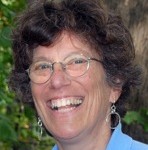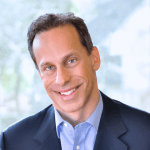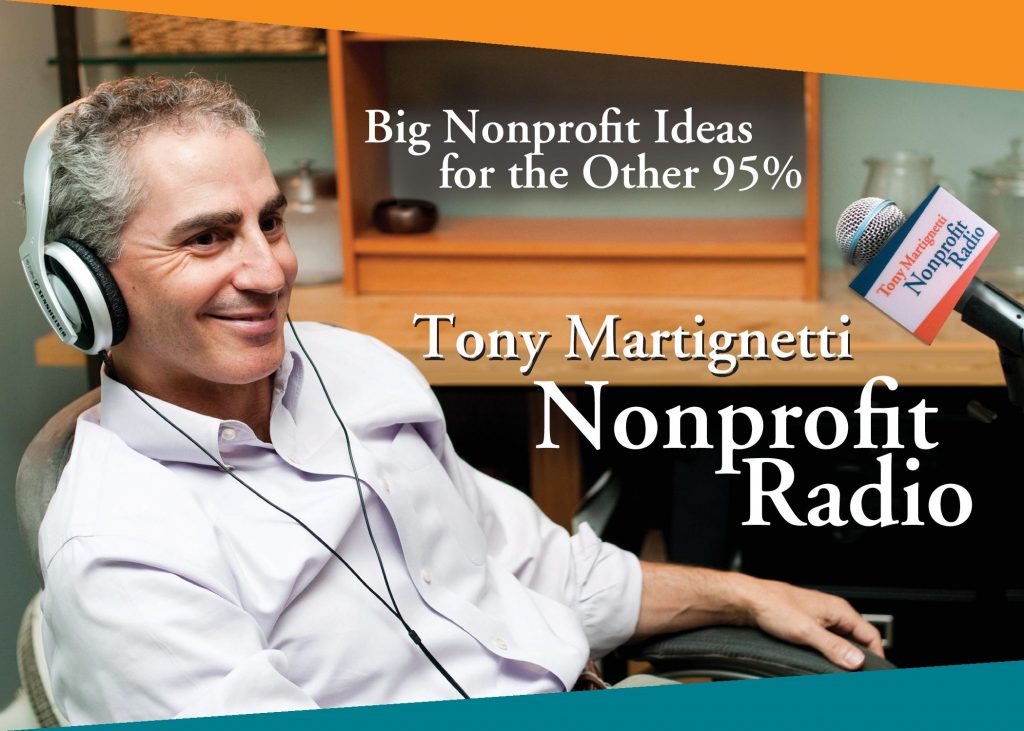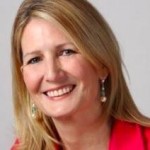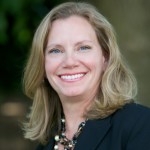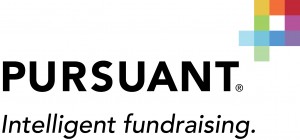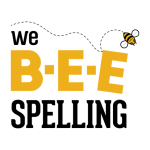
Gene Takagi: Lessons From The Sam Altman & OpenAI Headlines

Our legal contributor, Gene Takagi, returns to first, unravel the story in his clear, plain language way. Then he shares his wisdom on the takeaways for nonprofits including good governance, proper documentation, gift acceptance, commercial co-ventures, and more. Gene is managing attorney of NEO, the Nonprofit & Exempt Organizations law group.
Listen to the podcast
Podcast: Play in new window | Download
Get Nonprofit Radio insider alerts!
I love our sponsor!
Donorbox: Powerful fundraising features made refreshingly easy.
We’re the #1 Podcast for Nonprofits, With 13,000+ Weekly Listeners
Board relations. Fundraising. Volunteer management. Prospect research. Legal compliance. Accounting. Finance. Investments. Donor relations. Public relations. Marketing. Technology. Social media.
Every nonprofit struggles with these issues. Big nonprofits hire experts. The other 95% listen to Tony Martignetti Nonprofit Radio. Trusted experts and leading thinkers join me each week to tackle the tough issues. If you have big dreams but a small budget, you have a home at Tony Martignetti Nonprofit Radio.
View Full Transcript
S3 bucket containing transcription results: transcript.results
Link to bucket: https://s3.console.aws.amazon.com/s3/buckets/transcript.results
Path to JSON: https://s3.console.aws.amazon.com/s3/object/transcript.results?prefix=czM6Ly9hdWRpby5tcGdhZHYuY29tLzIwMjMvMTIvNjcwX3RvbnlfbWFydGlnbmV0dGlfbm9ucHJvZml0X3JhZGlvXzIwMjMxMjExLm1wMw–.1702002095.json
Path to text: https://s3.console.aws.amazon.com/s3/object/transcript.results?prefix=transcript/2023/12/670_tony_martignetti_nonprofit_radio_20231211.txt
Hello and welcome to Tony Martignetti Nonprofit Radio. Big nonprofit ideas for the other 95%. I’m your aptly named host and the pod father of your favorite abdominal podcast. Oh, I’m glad you’re with us. I’d get slapped with a diagnosis of lordosis if I had to shoulder the burden of knowing that you missed this week’s show. Here’s our associate producer, Kate with what’s up this week? Hey, Tony, this week we have lessons from the Sam Altman and open A I headlines our legal contributor, Gene Takagi returns to first unravel the story in his clear plain language way. Then he shares his wisdom on the takeaways for nonprofits including good governance, proper documentation, gift, acceptance, commercial co ventures and more on Tony’s take two. How I can versus why I can’t were sponsored by donor box, outdated donation forms blocking your supporters, generosity. This giving season donor box, the fast flexible and friendly fundraising platform for nonprofits donor box.org here is lessons from the Sam Altman and open A I headlines it’s always a genuine pleasure to welcome Gene Takagi back to nonprofit radio. You know who he is, but he deserves a proper introduction nonetheless, he is our legal contributor and managing attorney of Neo, the nonprofit and Exempt Organizations Law Group in San Francisco. He edits that wildly popular nonprofit law blog.com and he’s a part time lecturer at Columbia University. His firm is at Neola group.com and Gene is at GTC Gene. Welcome back to the show. It’s a pleasure to see you. Pleasure to have you. It’s great to see you as well. Tony, thank you very much for having me. Absolutely. Let’s start our discussion uh about the uh the Sam Altman and the OPEN A I and the, the potential implications for uh for our listeners in small and mid size nonprofits with, if you could just sort of summarize uh what happened between Sam and his nonprofit entity and his for profit or not his, but the nonprofit entity, the for-profit entity. And what inspired you to uh think about this and, and write a, a two part blog post at uh nonprofit law blog.com. Yeah, I mean, it’s a great story, Tony, it gets a little convoluted but, you know, it was dominating our headlines for, for a few days and I think a lot of people sort of lost sight um about like one important fact is that the whole organization started out as a nonprofit public charity. So this is, you know, a charity with charitable assets that decided, hey, we’re gonna develop A I in a way that’s gonna like impact the world. Um but we’re not gonna do it for the benefit of for profit investors, we’re gonna do it for the good of humanity, right? So that’s the way the charity was developed and why they thought, hey, let’s develop it in a charity. Let’s not develop this in a for profit, let’s do it in a charity. So just to, just to be explicit, open A I is a 501 C three uh Open A I Inc. Um And so that’s important, that’s important. It becomes important in the story. Open A I INC is a, is the, the charitable entity, the 501 C three. That’s right. Um Dan Altman is the founder of, right, founder and board member. Just as an aside, Elon Musk was one of the uh initial board members uh as well and might have tried to take it over but didn’t, wasn’t able to do that. But that’s another story. Um So, um they, they were formed in 2015 and they probably took a year or so to get going. And I don’t know that they expected to develop into such a prominent player in the field and the dominant A I player with uh chat GP T, right? So uh GP T chat G BT, I think uh a billion users within just like months or even, you know, several weeks is the fastest growing application I think uh in history. Um So uh an amazing thing now before we got to that stage, the nonprofit sort of realized, yeah, we’re developing this and, you know, we raised, I don’t know, like $100 million or so. Um, to develop this A I technology. But we need a lot more if we’re really gonna, like, produce something substantial. And that’s their, their original goal was a billion dollars. Yeah. And they couldn’t get there. So they said, you know, this faces some other nonprofits as well when they, when they want to do something at scale and they learn, you know, we actually need to sort of partner up or collaborate with for profit investors here and they’re interested in this technology as well. But we have to remember the whole idea was we’re doing this for humanity and not be controlled by a for profit investor that tells us what to do. Um So they decided to drop down a subsidiary, they formed a subsidiary. Um and then they took in investments in the subsidiary, but by forming the subsidiary, presumably they contributed some amount of technology that they had developed to this point. So they raised over $100 million and they developed technology and they contributed down to the for profit. Now other investors are investing in it. And you know, it got to the point where I think Microsoft’s um investment and Microsoft is the second biggest company in the world. So talking about a big player, I think Microsoft’s investment was in the realm of $8 billion I think in total. So, and there’s a lot of investment, you know, of course, not all at once, but um and they created the subsidiary which um was a limited liability company or LLC. So I’ll just refer to it as the LLC. Um And um, so open A I INC, the nonprofit has now contributed charitable assets to an LLC and is in partners, in essence, with all of these other for profit investors who have invested a lot more money than open A I did. Um But because open A I had charitable assets contributed into the LLC, which it created, um it sort of said before we bring in investors, let’s set the rules and the rules are, we’re going to make the LLC, you know, provide in the operating agreement and provide to any investors that invest in us, that this technology is going to, you know, be developed for the benefit of humanity. And um this is what the operating agreement um said and that is a private document so we can’t see the full thing. But um this is on open A I Inc’s website and it says that the operating agreement of the LLC provides, it would be wise to view an investment in the LLC in the spirit of a donation with the understanding that it may be difficult to know what role money will play in a post A I world. And the company’s duty to this mission, the LLC S duty this mission um will take precedence over any obligation to generate a profit. The company may never make a profit and the company is under no obligation to do so. So before Microsoft put in any money or any other investors put in money, this is the operating agreement that they are signing and accepting. So that’s the thing. The other thing they did was, they said the nonprofits board is effectively going to be the fiduciaries, essentially the board of the LLC as well. So they’re going to determine what is in the best interest of the LLC. So they’re wearing two hats. Now, one is as the hat of the board members of the nonprofit. And one is as the board members that sort of govern the LLC. Um And at some point, the board and Sam Altman or majority of the board and Sam Altman, the founder, um uh who is also the CEO of the LLC where in conflict. Um And the board decided that they didn’t want to keep Sam on a CEO. Now, they gave a reason for it and it was essentially that he wasn’t um open and, and that’s the, the board of the LLC, correct, which is the same as the board of the nonprofit. So it’s, it’s right, but it’s not the, it’s not the nonprofit entity board that I understand they’re the same people, but they operate in two different, they operate as two different entities wearing two different hats, just like a, a person could be an individual and a trustee or an executor and an in. So, so the, the, the LLC board and Sam Altman were in conflict. Yeah. And so let me say that they, they made the structure much more complicated than that. So there are other entities that are acting as partners for, for, for like let’s call this a hypothetical. We’re simplifying it. So this may not all be accurate because we don’t get to see all the private documents involved, but essentially the same people are involved in both um as as the governing body or the fiduciary. So the board members of the nonprofit seem to be the same as the board members of the LLC from a practical perspective. So I’ll, I’ll go along with you kind of just using that analogy, but with that sort of caveat or disclaimer. Um So, absolutely, because there was a third party entity, a managing entity in between the two but, and a holding company as well. But for simplicity, uh le let’s keep it to two. And, and it’s not, it’s not a distortion of the story. It’s just, it’s for our purposes, it’s, it’s not a significant detail. So, um again, this is not the news for, for everybody, but this is trying to learn some lessons here from, from what we um So yeah, wearing their hats as the fiduciaries of the LLC, they decided they were going to remove or terminate Sam Altman as CEO. Now, this alarmed a lot of people and particularly because I think it’s widely viewed that this was apr blunder, um, as well that the board members of the LLC, the same board members of the nonprofit and said, basically, we’re firing him because he wasn’t sort of, um, open to, to what he was really, you know, doing or um um they didn’t say that there was any fraud or any unlawful conduct. But I think, you know, the presumption was that he wasn’t really looking after the mission of the nonprofit that was built into the operating agreement and therefore the purposes of the LLC as well. He was really looking to advance the A I from a commercial context, let’s expand it and grow the scope of the business just like in the for profit world would traditionally do. Um But the board members kind of had this background. Um, you know, some of them anyways, academics and kind of people who kind of understood the charitable context of it and were more concerned with the ethical issues related to, to A I. Um and I think, you know, you’ve probably discussed that with some guests in, in the past as well. Um uh of uh artificial intelligence and what that might mean uh beyond just making the world easier for all of us because we can talk to machines there are some dangers with that as well. And I think the board didn’t felt, felt like Sam was like progressing on like, let’s make this this, you know, huge company and let’s dominate the space. Um And not thinking as much about the ethical considerations that the board had. It’s time for a break. Are you looking to maximize your fundraising efforts and impact this giving season? Donor box’s online donation platform is designed to help you reach your fundraising goals from customizable donation forms to far reaching easy share, crowdfunding and peer to peer options. Plus seamless in person giving with donor box, live kiosk. Donor box makes giving simple and fast for your donors and moves the needle on your mission. Visit donor box.org and let Donor box help you help others. Now back to lessons from the Sam Altman and open A I headlines. I I saw this sort of captioned in uh uh something I was reading or maybe it was even a video that I saw uh just, you know, a week or 10 days ago when this was all capturing headlines, it was basically a uh altruism versus acceleration is I won’t go too much down the rabbit holes because there, there is this whole effective altruism movement um that um was embraced, I think by one or more board members um that’s associated with Sam Ban and greed, sort of the whole um other area but avoiding that rabbit hole for the moment yes, that, I think that’s right, that, that there’s kind of like, are we doing this for a charitable reason? Because this is an LLC with outside investors who put in most of the money? But they agreed that, hey, this is the operating agreement, we are going to be operating really for the benefit of humanity and we may not expect a profit. And in fact, we were told, don’t expect a profit, think of this as a donation. But then when you terminate somebody, we thought this makes no sense. And then I think, you know, from the perspective of some investors, even though some of them, you know, were involved in the signing of this operating agreement and the employees of Open A I who are probably a lot of engineers and others who were involved in the tech world that probably weren’t involved in nonprofit technology. So not really thinking about the charitable of it, they had a huge uprising against this move that the board did. And so within days, you’ve got um Microsoft being upset and saying, you know, we may desire just to hire um uh Altman and run the A I division within Microsoft itself because by this time, open A I and Microsoft are now very embedded together Microsoft being the, you know, the primary um uh or the biggest investor in Open A I I believe. Um And uh a lot of their um sort of programs that were or apps that we’re familiar with. Like word and outlook now have open a I sort of structures built into them and I don’t know if you remember Tony. Uh Another aside, do you remember Flippy um from Microsoft’s old, like a I help. This is from the nineties where you could say help and clip uh animated paper clip would pop up on your screen. I didn’t know clipping by name. Uh Sorry, I’m sorry. Clip uh the, the designers of clipping, I didn’t know him. Uh I mean, I don’t know, clip, he could be a woman too. Uh uh who knows the gender of clipping anyway. Uh I didn’t know clipping by name but I certainly remember the little, the little animated uh paper clip. Yeah. Yeah. So that was Microsoft A I so open chat is like a huge evolution from, from that, right? And now it’s embedded in Microsoft’s stuff and it’s like a, a powerhouse chat G BT um program that, you know, Microsoft can make available for users of its programs. Um And that’s a big deal that, you know, if somebody threatens what that might end up being. Um They had kind of A II I think from their perspective, reason to say, hey, why are you firing the CEO who’s been, you know, growing open A I LLC at like an incredible rate and incredible impact. Um And it’s really, you know, uh jeopardizing our business at, at Microsoft beyond our investment which maybe we don’t expect money back, but we’ve been like using the technology and if there’s some threat to the technology because you’re not going to follow the lead of your CEO, um, then maybe we need to sort of see what our legal recourse might be and maybe other strategies like hiring Sam Altman away from you and what’s terminated, just hiring Sam. And I think close to 90% of the employees of open A I said we’re going to if you don’t bring back Sam A CEO um at that point and a lot of media coverage. So everything, the New York Times, the Washington Post, the New Yorker, the Atlantic, like everybody writing all about this. Um probably not from the legal perspective that, that I might want to see. But um uh and understandably so, but yeah, I, I think there was pressure on the board to say, yes, we know what our fiduciary duties are. We know that the operating agreement says that, you know, the LLC is gonna be, you know, operating the, the programs for the benefit of humanity, not for the benefit of our investors, but in light of all of this, we are going to bring back Sam. So Sam Altman is now CEO there are other conditions to it, including some board members who um led the termination of, of Altman and to leave the board. But other board members who are thought, you know, at least this is how, how the, the press release from open A I read some board members or, or some of the outgoing board members, I should say um that the new board members were strong enough to stand up to Sam Altman. Like, so we put in fiduciaries that are strong enough. So should he go off, you know, kilter and really, you know, pursue a commercial and not a charitable purpose? Um uh or over the charitable purpose, I should say, and the benefit to humanity that there are board members that will hold him in check. Um So that’s kind of in a nutshell, what’s happened here. So nonprofit board also in charge of the for profit joint venture. So it’s a joint venture because the nonprofit has some ownership of it and the other for profit investors have ownership of it. Um And there are all sorts of rules that we can talk about in those type of collaborations, but nonprofit board is essentially in charge of both. Um And they made a decision with charitable purposes in mind. Uh That didn’t go well with the other stakeholders, they got threatened um with something that could have really harmed or um just eliminated a large part of the value of the LLC. Um And now we’re back to where we kind of started, but with a slightly different board and I think the questions are, what have we learned from this? And, and where are we now with nonprofits and for profits collaborating this way. Yeah, absolutely. And those are our broader lessons uh which we’ll get to imminently. It’s time for Tony’s take two. Thank you, Kate. I’ve been thinking recently about the, the contrast between thinking about how I can do something versus why I can’t. And this has always been my philosophy to, to think about the, the, the positive rather than the negative. I feel like if you’re looking for reasons why you can’t do something, you’ll find plenty. They’re, they’re easier, they’re much easier to identify. They come to the surface so much quicker than the, how you can. So I don’t like to start with the why I can’t because they’re too easy and, and they’ll, they’ll just block you up, they’ll jam you up. I like to start with the how I can. And I’ve been thinking about this in terms of like bringing on a new client, opening a door to a new donor relationship, um, visiting donors when I take my trips up to New York City, this is how it’s been, it’s been showing up for me. So for you, I’m urging you to uh start with the how you can just because the why you can’t is so much more abundant, so much easier to find. It’s, it’s definitely tougher to find the, the way forward rather than identify the roadblocks. I fully understand sometimes there may be reasons why very good reasons why you just can’t do something, but I urge you to not start with that thinking, figure out the how you can instead of the why you can’t first and then hopefully you can, you’ll, you’ll find a way forward for whatever it is that whatever it is that, uh, is maybe giving you some pause in your work or, you know, personal life, the, the how you can instead of the why you can’t. That is Tony’s take two K. That’s a very optimistic. Look at thinking that way. You know, how people make a pro and con list. Why not just make a pro list and manifest good things that you can do what you wanna do. I like that. Ok. Ok. Uh, well, sometimes there are legitimate cons. Uh, so I wouldn’t ignore them. But yeah, I don’t, I don’t like to start there. Definitely. Don’t, don’t wanna start there. All right. You, you sounded a little surprised. Were you surprised that this is an optimistic way of looking like that? I would be optimistic. I feel like when I like, talk about maybe like an event coming up and I’m like, oh, I shouldn’t go because con con con versus, well, I should go because pro pro pro and I can go do all these things, you know. I’ve, I don’t know, I liked your philosophy. I think it works very well. Not just nonprofits but like, in life in general. Ok. Cool. I just, I, I was afraid that you thought you, you sounded like surprised that Tony would have an optimistic outlook on things. What a shock. All right. But you, you’re not shocked. So that’s good. We’ve got VU but loads more time. Yes, we do. Let’s go back to lessons from the Sam Altman and open A I headlines with Gene Takagi. To me, this is a, a positive story for, for nonprofits. I mean, the, the, the humanitarian mission overcame the uh the uh the desire for, you know, acceleration is in, in profit, in, in, in potential profit making, maybe it’s too early to tell. But at this stage, I mean, I’m not saying this, this, this is gonna be the ultimate. But at this stage, I don’t know, I was pretty optimistic, maybe, maybe, maybe you disagree. But I, I felt that with, with the, with the, with the guard rails in place that uh overall, it was a, it was a positive story for non, for the nonprofit entity. Well, I, I think the positive story is in the creation of open A I and when they first developed the LLC um like that, that was certainly a positive, it’s like nonprofits and then for profits collaborating to make something really good at scale. Um And that goes outside of A I and the technology world, you know, one good example of, of this is National Geographic, that’s a joint venture um which is now uh between Disney and the nonprofit National geographic where Disney owns about 73% I think, um, of the stock of that joint venture and the nonprofit owns 23%. But each of them put four people on the board of that LLC. That’s also an LLC. Um, so that the nonprofit has an equal say essentially. And there are sort of guardrails there as well as to what the nonprofit must allow and not allow the LLC to do so. Because charitable assets are involved. Again, the nonprofit needs to have control over those charitable assets and how they’re used. So that would have held true here as well. And that’s why we have part of the reason why we have that operating agreement that the LLC um giving, you know, the, the board of the nonprofit to be the board essentially of the LLC and all these provisions saying that investors may not make money from this. It’s, you know, really about the benefit of humanity and, and in 501 C three terms, the ability of the LLC. So, yeah, the lesson is, yeah, there are some good laws that create these guard rails. Um And there are some people who are involved that really were interested in doing, you know, doing a I right the right way. But I think on the, on the other hand of it and sorry to be the pessimist in the holiday season. But on the other hand, or the other side of the coin is, the money always wins. You know. So, well. But we don’t know, we don’t know if that’s gonna happen, do we? Well, we know Sam got rehired, right. Altman got rehired as the CEO of the organization. And yes, they said there’s gonna be more controls because the board members are the new board or people that hold him to check. But the, the, the new board members are also kind of for profit people, right? They’re not other sort of nonprofit leaders are like they’re, they’re more well known for, for their investment expertise and what they do in the for profit world and technology world, which is important too. Um And, you know, we can sort of go into, you know, some people wanted to write an immediate reaction kind of in the nonprofit law world that I reside in is, hey, these are charitable assets. They did what they thought was the right thing to do. You’ve got to protect those charitable assets and those charitable assets always have to be used for charitable purposes. Uh unless they’re sold for fair market value in return, which I don’t think is the case here. So charitable assets involved got to be used for charitable purposes. But I think there’s a bigger question too. Um And the question is if the fiduciaries just held true and said, yep, we’re not changing, we’re not hiring Sam back because we want to do this the ethical way. And Microsoft went and hired Altman and 90% of the staff of Open A I and Open A is other investors lost confidence in the organization. Let’s say the organization tank. Um, there was, you know, the, the, about the $100 million investment that might have been made by the nonprofit that might be worth billions of dollars right now that the nonprofit could have all seen wiped away and all of those assets would be bound by charitable trust that had to be used for charitable purposes associated with it. So, you know, on one hand, it’s like, yes, you know, we have to stay true to our mission. But on the other hand, it’s like we own a really valuable asset. And if we do something that tanks the value of that asset to, to where it doesn’t have very much value anymore, is that consistent with our fiduciary duties? So I think there’s really sort of tougher questions in there. And again, because we don’t know all of the private documents that exist with the, the complex corporate structure. We don’t know exactly if it’s that simple, but I think that’s one of the considerations to have and why we’re not completely sure. I, I guess between your optimism and my pessimism, it is, we’re gonna have to wait and see what happens. OK. All right. Let, let, maybe we’ll come back to it in six months or we’ll see, we’ll see what’s, we’ll see what’s developed it. May not even be, who knows the way things move so fast. But in any case, we, we’ll, I’m sure we’ll revisit this. Let’s, let’s broaden to uh some of the, some of the lessons for uh not, not for, uh you know, a smaller mid-sized shop, having a, a for profit subsidiary, governed by a managing entity and entity that uh but there are, there are um takeaways for our, our, our um our routine sort of contracts with and, and partnerships with for profit companies that, that around fundraising um around some of the other char well, the, the uh the commercial co ving. So let’s talk about some of the lessons that we can take away. Yeah, I think that’s a great way to sort of take, take some lessons out of this open A I structure and make it real for, for, you know, our, our listeners here. Um And, and I think one, maybe the first one is not just for profit companies when, when you’re partnering with individuals as well. And let’s start with your kind of realm of the world. Uh and the nonprofit sect Toian fundraising, let’s say you’re representing a charity has a million dollars in, in gross revenues and is, you know, doing great work. And a donor comes along and says, I will give you $2 million that’s twice your annual gross revenues, but you must do this with my $2 million. Now, would you automatically accept it no matter what their conditions are. Um Or would you say, hey, we actually have to, to see what, what, what those conditions. Yeah, of course. You know, what, what, what are you, what are you asking us to do? And is it consistent with our mission with our organizing documents? Uh So I’m certainly happy to have a conversation and isn’t that kind of the open A I issue as well? Right. You’ve got for profit investors that say, hey, we’re gonna give you a ton of money and yeah, we’re not gonna ask pretty much from you because we said, you know, this was all like, this is what we all want. But when you fired your CEO now we’re upset now, we want to know what we can do to change that and donors can be the same way, right? I mean, so super major donors that are very demanding, upfront when they put their conditions on, it might be something that the nonprofit might be able to accept, but you should actually know what the history of that donor is as well. Like how, you know, once they made their gift legally, that relationship should be, you know, over unless there are other contracts involved. But if it’s a gift, they made their gift, they get a deduction, you know, from, from the gift and the control of that gift lies with the, with the nonprofit. And generally speaking, the donors really can’t sue the nonprofit. If they misuse the gift, it block that, that lawsuit would belong to the attorney general. So the donor would complain to the attorney general and the attorney general would say, hey, you’re not using it for the restrictions that were imposed by the donor that you agreed to. You know, we’re gonna step in and, and make sure that that happens. Um, and we’ll, you know, we’ll go to court if you’re not complying with it. And we might find you as the attorney general of the state or the state charity official. Donors can sometimes have rights in some states by contract if they entered into a contract. Um But largely it’s with the regulator that that’s going to deal with it. But if you’ve got a donor and you see this again, maybe outside of the normal listeners, but like in the university context and stuff where they’re asking for a lot of things and when you do something that they don’t like, they start to leverage it and maybe it’s because they leverage it with future donations that they could withhold that you thought you might get, um or they leverage it with a media attack against you and the leadership. Um So you wanna know a little bit more about that donor as well, not just the conditions, but is that donor litigious? Do they use pr to attack past relationships? Um um You know, so learning a little bit more about that when when you’re gonna get a big gift and when it’s conditioned, um, heavily where, you know, and, and this is not sort of the typical. We wanna just make sure you use it to, to advance children’s education in Los Angeles rather than in, you know, other cities we’re talking about like a gift that is like, suddenly quasi charitable, right? Like you’re not even sure if it’s really charitable or not, or the condition is so strange, um, that, you know, it should come up to the board for the board to decide whether we really want to do it because of this, because of the conditions that are attached. And, you know, you could add another layer. Uh I could add another layer to what you were hypothesizing, which is the person could be a board member and, and a major donor. So, you know, they can cause trouble for the leadership because they are a fiduciary. And, you know, they can claim that the organization is, is breaching its duty to its mission because it’s not adhering to the terms of my agreement, which is more in line with the, the mission. And, you know, you can imagine an argument, uh uh you know, a, a long played out a long played out uh difficult relationship uh on that level too. Um All right. So that, that’s very good. You know, it’s, that’s valuable. That’s, it’s not only, it’s not only corporate or even incorporated entities of any type profit or for or profit or nonprofit. Uh It’s gonna be a relationship with an individual that you need to be very scrupulous about. Yeah, that’s, that’s very teddy and not to say that, you know, we, we need to be super cynical about every goal that we have. No, but, but, but uh go in with eyes open, you know, you need, you need to, you need to protect what you founding documents and what your mission on your website says. Absolutely tiny, what else, what are, what are, what other uh lessons here? So, you know, I think there are other sorts of collaborations that nonprofits may have, including smaller nonprofits with for profit organizations or individuals including like, oh, we want to like fundraise together. Um You know, perhaps it’s um cause related marketing. Um So somebody is going to say, hey, you know, buy uh some of our goods and we donate, you know, 1% of our proceeds to charity. Um And that’s a, you know, a, a collaboration that has some importance to the nonprofit, right? So, you know, again, as a fundraiser, Tony, you probably want that what that company, you know, who that company is and how they’re run before you agree to let them sort of promote the charity as sort of um kind of a partner if you will um in, you know, in layman’s terms um with the for profit, in raising funds. Now, you know, if you get 1% of, of that, that might be, you know, great money that you wouldn’t have seen otherwise. Um, but we also know that there are a lot of scams that have gone on and sometimes those are with, like, it, it used to be robocalls. Right. I don’t think we have that so much now in our, in our world but it’s, um, uh, sort of email and, and other sort of, uh electronic messaging now. But Robo calls from, you know, charities, um, which were actually commercial entities that are saying, hey, you know, we’re fundraising for this charity that’s associated with the police or with the firefighters support us and, you know, you know, your proceeds will go to that charity and it turns out, you know, maybe 1% 2% or some minuscule amount would go to charity. And that commercial operator that Robocall was making all the rest of the money, um for providing that fundraising services. And some charities would say, hey, that’s one, you know, percent, you know, that’s money we wouldn’t have gotten in any way. So go ahead and use our name. But in the end, you know, that could really blemish the charity’s reputation and, you know, its relationships with donors because that seems pretty deceptive. Um, uh And so you have to be careful and that, that’s, those are extreme cases, but there are going to be those gray areas where you say, I don’t know, if going into this relationship with this organization and what they’re selling and how they’re using, our name is good. So you gotta be careful of that as well. If we’re gonna lend our name to something like this. Uh uh I mean, at the most basic level, we need to make sure that this is not just a handshake agreement, there needs to be a written agreement. Uh A as, as you’re thinking, you know, as you’re speaking, I’m thinking there has to be a way for the charity to remove itself if there, if anything happens that, you know, just, I don’t know, broadly would bring discredit to the, to the nonprofit name or reputation or, you know, anything, something broad like that. So that if the, if the president of the car dealership is, um, uh, you know, caught up in some kind of scandal, even just accused of something, let, let’s keep it, let’s keep it financial and not anything, you know, lascivious, but, you know, they’re accused of some kind of financial crime that, that, that brings discredit to the nonprofit and we can, we can walk away from this. Yeah, I mean, that’s just, and that’s just a basic, uh, that’s just a fundamental term I would think. But there has to be a writing between the two, the, the two, parties that are gonna, uh, work together and most states require some sort of writing and some sort of provisions in that writing to protect the charity in those relationships, um, under a lot of state laws, they call this commercial co venture, um, rather than cause related marketing, but kind of the same type of relationship where a for profit is out there using the nonprofit’s name with permission. Um, and saying to the public, if you buy some of our services or some of our goods, the car that you mentioned, then a percentage or some portion of our uh revenues, uh, or the, the funds that we get from the sale, we’re gonna go to charity and you know, having something in writing is great and you know, required provisions in the contract is great, but you’ve got to even do more than that because you know what if they give you, what if you’re the head of a charity and they give you a check for $10,000 at the end of the year and say, hey, this was all we raised. We thought we were going to raise $100,000 for charity, but we didn’t sell that much. How do you know, how do you know they didn’t sell a whole lot more? And what obligation did they have? You know, were they holding the $10,000 for a year, were they holding it for a week? Um And there, there are laws, uh, you know, depending upon what state you’re in about how that works. So, for charities, the obligation is if you’re going to enter into that type of, uh, relationship, make sure, you know, the laws involved as well because there may need to be a specific type of contract that’s involved. You might need to have, um, that other party register and report on this and you might need to build into your contract, certain things that allow you to be able to audit, um, what that organization is doing, at least, you know, on, on their books or on their paperwork. Um There could still be fraud. So you have to always be cognizant of, of uh the reputation and the history that your other partner again loosely um stated is, but you, you, there’s a lot that goes into that and again, just like with open A I and its relationship with its investors, you, you have to know something about that other party and you have to have this mutual understanding that should be documented in agreement just as you said, you mentioned registration. Uh a lot of the laws in states that require registration for charitable solicitation also require registration of commercial conventions. That’s right. Um And uh reporting, I mean, it might be with each form of solicitation or might be on an annual basis. Um So, um something to, to pay attention to, again, as a charity, you have a responsibility to make sure you’re contracting with parties that are permitted to do the work that they say they’re gonna do for you. So it’s not just their fault, it would be your fault is the charity leaders. Um if you enter into a relationship like that and it isn’t compliant with the law. So, be careful of that. What else should we talk about, Jean? Um So we can talk about a little bit about, well, partnerships where um there are actually kind of nonprofits looking for a little bit of money um from, for profit investors who want to do something with what the nonprofit is doing. And it might not be, you know, in the millions or billions of dollars that we’re talking about with open A I, it might be in the thousands of dollars. So you’ve got a nonprofit program. Um And you know, you think that there might be some people interested in supporting it, but they don’t want to give you a loan, they don’t want to give you a donation, but they said, hey, let’s go into some sort of business together and we want a piece of, of sort of the equity in it. And this happens again in a little bit of a bigger context all the time in low income housing. Um So for for profit developers to get low income housing tax credits from the government, they have to be partnered with a nonprofit in order to do that. Um So the only way to access those tax credits is to partner with a nonprofit. So in, you know, in that case, the nonprofit again has a whole bunch of rules involved in terms of, well, you’ve got to protect the charitable assets that you are contributing to this joint venture that’s co-owned with for profit investors. You’ve got to make sure that the nonprofit purposes are being advanced by that joint venture. Um, so again, if you’re thinking about it, even in a small context, not involving, you know, a lot of money, but even in a small term, like, let’s start a small LLC together and, you know, the nonprofit is gonna put in $20,000 and for profit investors are going to put in $20,000. Um, and we’re gonna do something that furthers the charitable purposes, but that is outside of maybe what 501 C three allows or it’s only gonna be capable of doing it at this scale because there are people who want their money back as shareholders or they want to have skin in the game as well, right? Um So if they’re gonna do something like that, again, laws involve that protect the charitable assets, so you have to do it carefully. Um, you know, 20,000 $20,000 is possible, but you, you, you, you’re gonna have some associated costs and of course, if you’re gonna also manage, uh, a joint venture, you have to be very careful about, um, keeping an arm’s length distance with the nonprofit, even though you need to have a certain amount of control of it. So again, just like the open A I thing, but on a much smaller scale it gets to be complicated stuff. Yeah, this sounds like walking a tight rope between, between the, between the two entities. Um All right. I mean, you’re, you’re saying it’s, it’s, it’s done but it needs, uh, obviously it needs to be done delicately. Now, I see this happening a little bit more often nowadays because there are like government incentives um for small businesses like so, um sometimes it’s, it’s minority owned small businesses, sometimes it’s women owned small businesses and there are sort of government funding to spur on these businesses and nonprofits are sometimes excluded from that. But the work that is to be done is often, you know, in the public interest, which is why the government is funding it in the first place, right. So it’s something that a charity could do and it might be a minority led charity or a woman led charity that wants to get in on it, but they can’t get in on it because those programs are designed for small businesses only. Um And that may not have been the intent of the legislative body that created that, that fund to exclude nonprofits that are led by those um uh persons that face sort of economic disadvantage in certain areas. So it’s interesting, some nonprofits are forming for profits for the purpose of being able to compete on those government bids. And what realms are you seeing that is that also mostly housing? No, in, in all sorts of realms from uh disaster relief, for example. Um um uh So, uh yeah, and, and you can find it in uh education as well. So, uh distance learning education um largely was kind of a concept of joint ventures as well. You had four profits that wanted to put up the money and you had a nonprofit that had the skills and the teachers, right? So a lot of distance learning, um um, now they’re in apps and stuff and in websites. Um, but when they first started, they, they were often done through joint ventures between educational institutions that were nonprofits and some uh investors or educational providers that were for profits. Anything else, uh, that you want us to be aware of when we’re partnering with some other entity? Yeah. So there’s a, you know, the, the big concept that everybody is concerned about from a regulatory perspective is 501 C three s are not allowed to give prohibited private benefits to anybody, right? Not just insiders where we call it private endure if like a board member benefits too much from an organization. Um, um, but for anybody to be overcompensated by a charity, um, for any reason, uh can be seen as a prohibited private benefit. Um And if it’s an insider, like a director or officer, there can be penalties on that individual and they would be required to return the money as well. And the board members who approve that transaction could also be personally liable for some penalty taxes as well if that private benefit is extended to an insider, like a founder board member, you know, high level manager or officer. Um, but if it’s to anybody, an outside vendor and you didn’t vet the situation well enough to know that, oh, they’re actually getting more than what they contributed um to us, more than what they paid for. They’re getting more value from the charity. So it looks like it’s a diversion of charitable assets, right? So if you overcompensate, for example, somebody who developed a website for your organization and the commercial rate would have been, let’s say $10,000 for this and that person did the exact same service that their competitors might have done, but charged you $50,000 for it. And the board just simply didn’t know what the commercial rate was and approved it without any intention of doing anything wrong. That’s still a private benefit transaction. And that could threaten uh an organization’s exemption. So, be careful, um, when you sort of enter into transaction with, for profits, even if they’re vendor relationships to make sure that you’re not overcompensating anybody and always be super careful if it’s an insider that’s involved. So a board member officer, you know, that has a company and they’re entering into the contract and, or office space. I see that often board member, board members giving office space to uh to, to the, to the nonprofit. But you’re talking about not giving or you’re talking about, you know, beyond market rate uh when they try to market rate transaction. So, all right. Well, so this goes back to, to uh the, the due diligence that you and I talked about years ago around uh private benefit transactions that were related to insiders c suite board members, uh founders, you know, so it’s the same due diligence supplies just uh it applies to a, a commercial entity as to your due diligence around a commercial entity as well. And, and what, what’s appropriate compensation for them? Yeah, and that wraps back into the open A I issue as well without knowing it. But I would consider that the, the board may have been concerned that they were extending a private benefit um to its outside investors by operating for commercial purpose, even though they’re organizing documents or their operating agreement said, hey, we’re doing this for humanitarian purposes and you might not get any profit coming out of this interesting gene. All right. Well, that’s savvy thinking. All right. I see uh anything else that we should take away from our potential relationships with other entities? Um Open eyes is what you said earlier. And II, I believe that that’s 100% true, Tony. So, yeah, most people are good. Most, you know, most people are trying to do the right thing. Um But keep your eyes open. Um And not just with respect to, to um what you know, who you’re dealing with, but also with respect to kind of what laws might apply. Um So, um stay, stay in touch with kind of the important resources that you need. Keep yourself safe, keep your nonprofit safe, stay safe. All right. Thank you, Gene Takagi. And it’s the nonprofit law blog and the uh firm is at Neo Law group.com. Gene is at G Tech. Thank you very much. Gene always uh always learn more than more than I can, more than I can manage in, in one sitting. I have to listen back again. Thank you very much. Thank you so much, Tony. Next week there is a 57% chance it’ll be performance measurement if you missed any part of this week’s show, I do beseech you find it at Tony martignetti.com were sponsored by donor box, outdated donation forms blocking your supporters, generosity. This giving season donor box, the fast flexible and friendly fundraising platform for nonprofits donor box.org. Our creative producer is Claire Meyerhoff. I’m your associate producer, Kate Martinetti. This show, social media is by Susan Chavez, Mark Silverman is our web guy and this music is by Scott Stein. Thank you for that affirmation. Scotty be with us next week for nonprofit radio. Big nonprofit ideas for the other 95% go out and be great.


